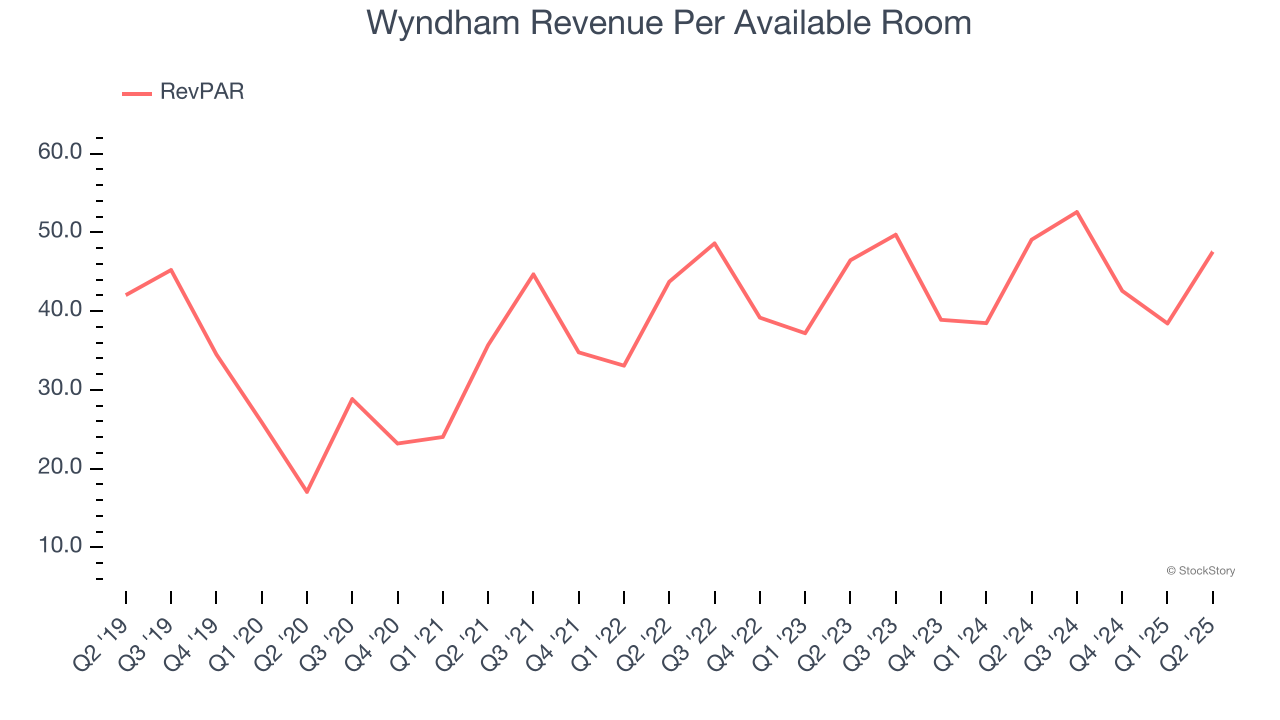
What a brutal six months it’s been for Wyndham. The stock has dropped 21.4% and now trades at $87.95, rattling many shareholders. This may have investors wondering how to approach the situation.
Is there a buying opportunity in Wyndham, or does it present a risk to your portfolio? Dive into our full research report to see our analyst team’s opinion, it’s free.
Why Is Wyndham Not Exciting?
Despite the more favorable entry price, we're swiping left on Wyndham for now. Here are three reasons why you should be careful with WH and a stock we'd rather own.
1. Weak RevPAR Growth Points to Soft Demand
We can better understand Travel and Vacation Providers companies by analyzing their RevPAR, or revenue per available room. This metric accounts for daily rates and occupancy levels, painting a holistic picture of Wyndham’s demand characteristics.
Wyndham’s RevPAR came in at $47.55 in the latest quarter, and over the last two years, its year-on-year growth averaged 2.8%. This performance was underwhelming and suggests it might have to invest in new amenities such as restaurants and bars to attract customers - this isn’t ideal because expansions can complicate operations and be quite expensive (i.e., renovations and increased overhead). 
2. Projected Revenue Growth Is Slim
Forecasted revenues by Wall Street analysts signal a company’s potential. Predictions may not always be accurate, but accelerating growth typically boosts valuation multiples and stock prices while slowing growth does the opposite.
Over the next 12 months, sell-side analysts expect Wyndham’s revenue to rise by 3.8%. While this projection indicates its newer products and services will spur better top-line performance, it is still below average for the sector.
3. Previous Growth Initiatives Haven’t Impressed
Growth gives us insight into a company’s long-term potential, but how capital-efficient was that growth? A company’s ROIC explains this by showing how much operating profit it makes compared to the money it has raised (debt and equity).
Wyndham historically did a mediocre job investing in profitable growth initiatives. Its five-year average ROIC was 11.4%, somewhat low compared to the best consumer discretionary companies that consistently pump out 25%+.
Final Judgment
Wyndham isn’t a terrible business, but it doesn’t pass our quality test. Following the recent decline, the stock trades at 17.8× forward P/E (or $87.95 per share). Beauty is in the eye of the beholder, but our analysis shows the upside isn’t great compared to the potential downside. We're fairly confident there are better investments elsewhere. We’d recommend looking at a fast-growing restaurant franchise with an A+ ranch dressing sauce.
Stocks We Would Buy Instead of Wyndham
When Trump unveiled his aggressive tariff plan in April 2025, markets tanked as investors feared a full-blown trade war. But those who panicked and sold missed the subsequent rebound that’s already erased most losses.
Don’t let fear keep you from great opportunities and take a look at Top 5 Growth Stocks for this month. This is a curated list of our High Quality stocks that have generated a market-beating return of 183% over the last five years (as of March 31st 2025).
Stocks that made our list in 2020 include now familiar names such as Nvidia (+1,545% between March 2020 and March 2025) as well as under-the-radar businesses like the once-small-cap company Exlservice (+354% five-year return). Find your next big winner with StockStory today.
StockStory is growing and hiring equity analyst and marketing roles. Are you a 0 to 1 builder passionate about the markets and AI? See the open roles here.






